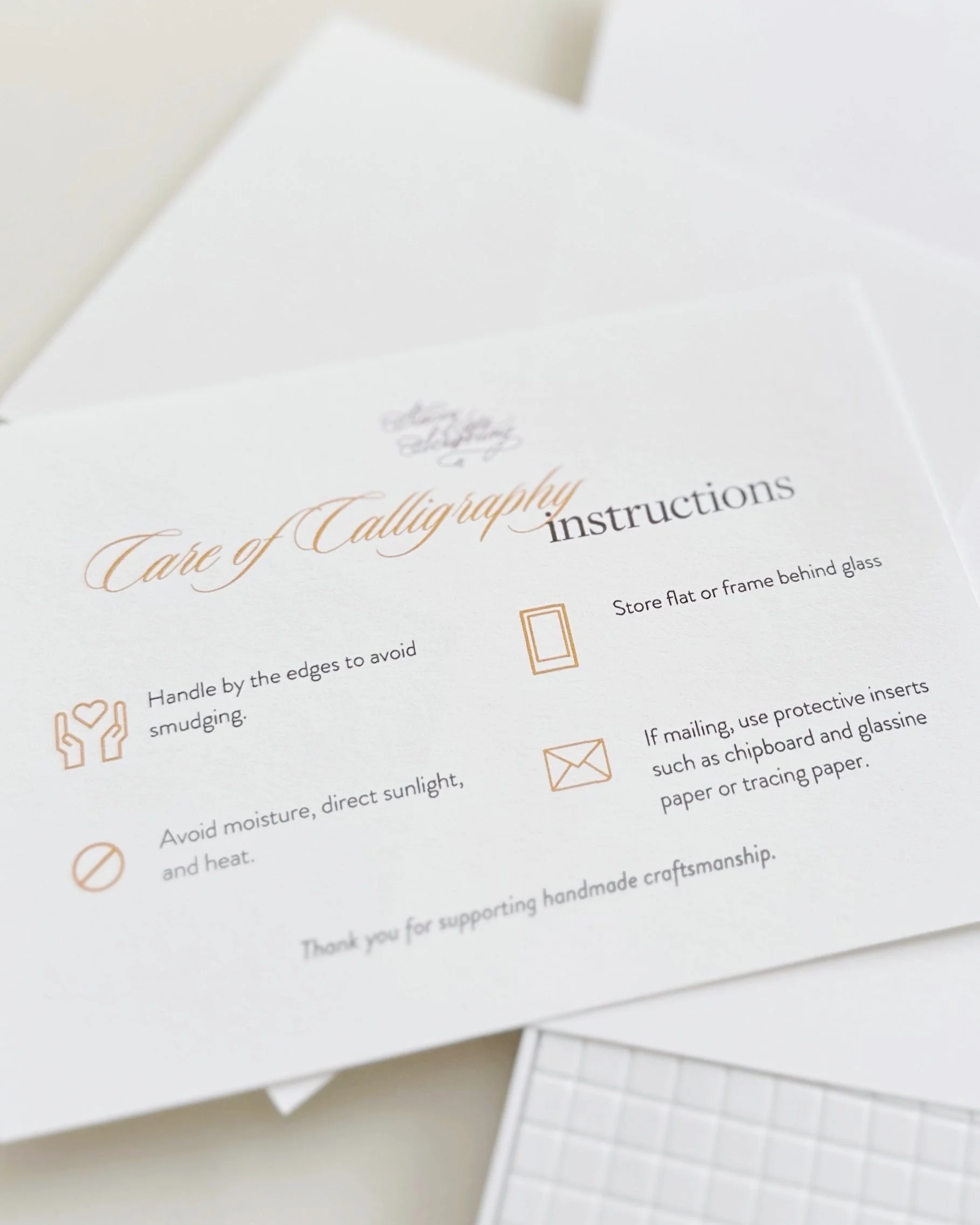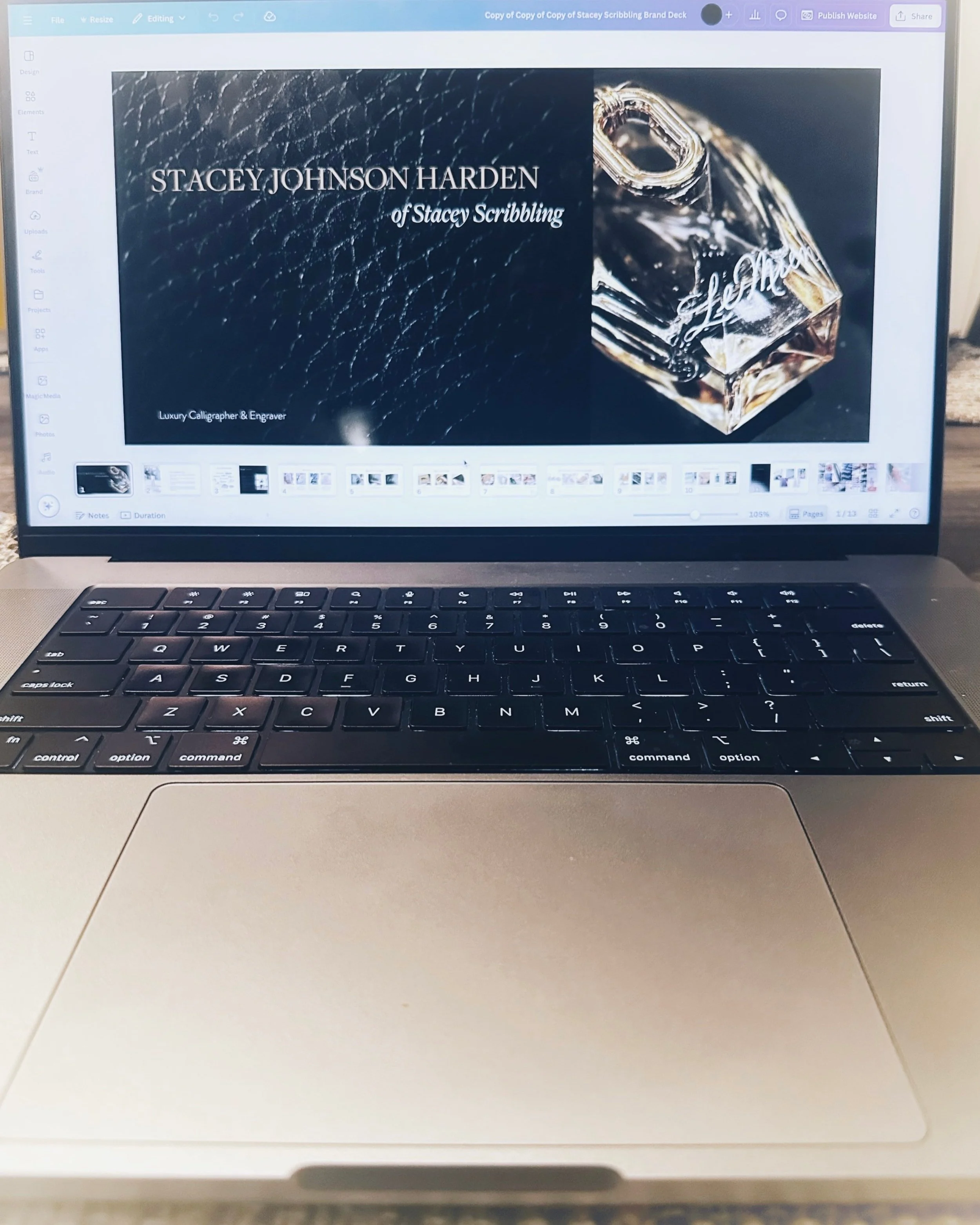What Calligraphers Really Do Between Events (And Why It Matters to Clients)
You’ve seen the videos.
Slow-motion engraving pen gliding across a perfume bottle…Foiled initials catching the light…Smiling guests watching the magic unfold as a calligrapher busily customizes their new favorite thing.
But what happens when the artist packs up her tools and the event lights dim? Spoiler alert: It’s not a vacation.
In fact, some of the most important work calligraphers do happens between events—off the stage and out of sight. Whether you’re a fellow artist or a brand hiring one, here’s what’s really going on behind the scenes.
Studio Work Is Strategic, Not Spare Time
When we’re not engraving at a beauty counter or customizing tags with our cool calligrapher friends at a luxury lounge, often we’re deep in the studio. There it’s all inking, fulfilling, designing, and shipping and might include:
Custom client commissions
Handwritten (or semi-handwritten) brand mailers
Signage and packaging for events or in-studio work
Wedding calligraphy suites, envelope addressing, etc.
Creating documents to help clients access services better
Meeting with clients
Large, custom work
This is where we finesse our craft, free from the time pressure of a live crowd, but still serving real people with real deadlines. I personally pick up all local orders and make mockups for clients before I get started customizing their items.
This is my second year taking in-studio requests and I finally found the time to create a resource for them to help package items for drop off (adding this download to the next drop for my Backstory Insiders) as well as packaging inserts for flatwork that needs care once received.
Client Prep Starts Way Before the Event
Clients might only see the 3-hour activation window. But artists are:
Surface testing: Will the foil stick? Will the ink dry on this leather? Can I engrave this stone or glass without cracking it?
Packing and kit prep: Ensuring tools are clean, charged, and backed-up (because the Sharpie can’t save you when you’re engraving; but a gold or silver one can be a life-saver when the foil fails).
Event coordination: Emailing timelines, securing parking, confirming dress codes, reviewing brand tone and script preferences.
Shipping materials: Those who work global activations are deciding whether to fly with their kit or send personalized materials ahead of time.
So yes—we’re artists, but we’re also logistics pros and problem solvers for our clients.
Quiet as kept, clients paying a premium price for a live artist want as much as possible to set it and forget it. Quick-thinking and ingenuity is really valuable to them. The ability to reconcile that while making your job seamless to do is an art in and of itself. One of the most important items on the list is making sure your materials jibe with the surface the client will provide. Nobody wants a mess on the day of the event. Yet, though it’s not considered as much, nearly 99% of the time I still pack multiple post-it notes stacks and other similarly shaped items because you never know when a wobbly table may need the extra support. The client doesn’t notice you had to fix the table during set up. But, you and the client will surely better appreciate the art you create from a table that stays put!
We're Running a Business, Too
When the nib (or the brush) is down, the admin is up:
Responding to inquiries
Sending invoices and contracts
Updating our portfolios and proposals
Creating social media content
Following up with leads
Managing expenses and supplies
Many of us are solopreneurs doing the jobs of five departments. That energy you see at your event? It’s backed by hours of planning, promoting, and, yup…more problem-solving.
Practicing, Learning, and Evolving
Between events is when artists stretch:
Practicing new letterforms or engraving techniques
Taking courses or mentoring others
Creating samples for brand kits or portfolios
Experimenting with new materials like foiling on denim or engraving stoneware
This is creative incubation. It ensures we don’t show up to your activation with the same old script and a stale hand.
It’s a time to brush up on less-practiced skills. Above, I’m using a technique typically referred to as manual fill to apply color to an engraving. It’s normally used when the surface won’t take gilded waxes without smearing. I don’t get many requests for it, which is just as well because I find it a time consuming process. But, I still think being able to do it adequately is a must-have skill that you pray to not have to use that much. 😅
I also tend to take new-to-me courses during my winter, spring and summer breaks. I take courses on things I want to learn or need to brush up on. And, this year, I got to knock a goal off my bucket list with Suzanne Cunningham’s Majestic Majuscules Class. That will come in handy for creating some super-elegant names this holiday season.
Rest Is Part of the Workflow
No one can pour from an empty ink jar. Resting between activations is essential to delivering excellent work. That includes:
Recuperating from travel or long event hours
Resetting our bodies (hello, calligraphy cramps!)
Taking intentional creative breaks to avoid burnout
Attending calligraphy retreats to recoup and often learn how to upgrade services with fellow calligraphers
Brands, take note: rest is not laziness. It’s strategy.
What You’re Really Hiring
When a client hires a calligrapher or live artist, they’re not just paying for pretty lettering during a 3-hour event window. They’re investing in everything that happens before the pen even hits the surface.
Here’s why that matters:
You avoid on-site surprises. Surface testing, kit prep, and mockups ensure your materials work, your setup looks polished, and your event flows smoothly.
Your brand is represented with excellence. Calligraphers don’t just write—they help embody your brand’s tone, elegance, and attention to detail. That takes planning, alignment, and practice long before the event.
You get a problem-solver, not just a pen. From troubleshooting wobbly tables to adapting scripts on the fly, live artists bring creative thinking and calm under pressure.
You save time and stress. A seasoned calligrapher anticipates needs, communicates clearly, and arrives ready—so your team can stay focused on the bigger picture.
You create a better guest experience. All the unseen work makes the live experience feel magical, memorable, and seamless for your guests—exactly the impression you want your brand to leave.
And if you’re a fellow artist? Share your tips.
Also…Let this be your reminder that the quiet seasons really matter and make you the value-add that you are. They are where your unique brand of magic refuels. 😌






